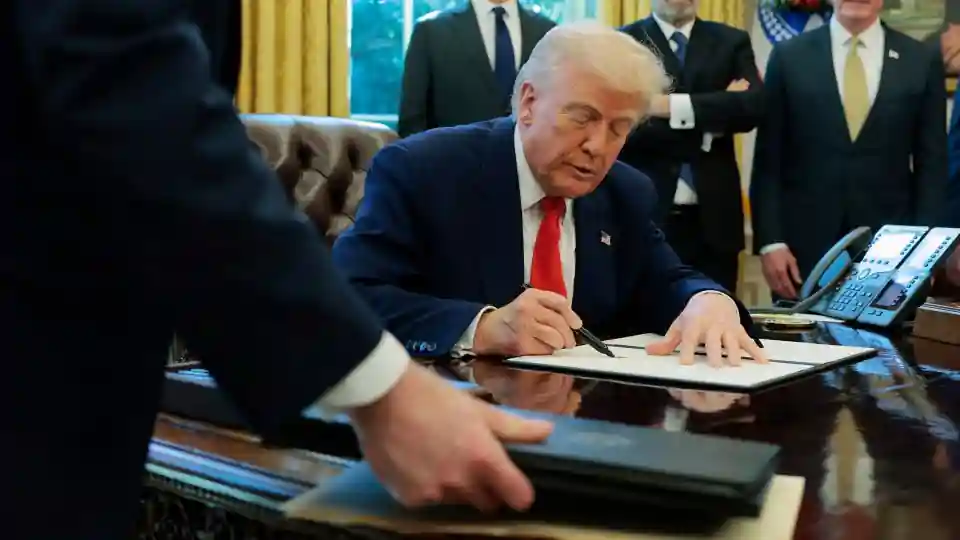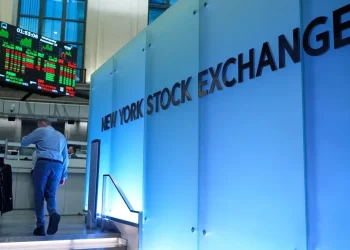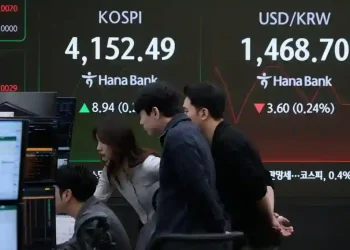Trump’s 90-Day Trade Deal Challenge: Financial Markets Remain Skeptical
President Donald Trump’s administration has embarked on an ambitious plan to strike 150 trade deals in just 90 days. The idea is to leverage high tariffs as a negotiating tool to bring countries to the table. While the strategy is built on the premise of intimidating global trade partners, the financial world isn’t convinced. Market volatility, rising yields, and a plunging dollar suggest that investors are skeptical about the U.S. successfully pulling this off.
The stock market has been anything but stable as investors react to shifting tariff announcements. After a dramatic sell-off on Thursday, stocks stabilized briefly on Friday, with the Dow climbing 450 points, or 1.1%. Despite this, volatility has surged, and any new tariff announcement seems to send markets swinging. For instance, when the Trump administration clarified the math behind China’s tariff, stocks plummeted, with the Dow briefly falling by over 2,000 points.
In the 129 years of the Dow Jones Industrial Average, there have been only 31 days where the index moved by 1,000 points in either direction. Four of those occurred in just the past week. Even with a historic gain on Wednesday, stocks remain well below their pre-April 2 levels when Trump unveiled his controversial tariff plan.
Typically, investors flock to bonds in times of turmoil, given their reputation as a safe haven. But this time, bonds are bucking the trend. Instead of rising, bond prices are falling as market participants lose confidence in the U.S. trade policy. The yield on U.S. Treasury bonds surged above 4.5%, up from under 4% earlier in the week, which is a huge shift for the market.
A steep increase in yields could have negative consequences, particularly for consumers with loans tied to these rates. With the bond market on edge, analysts are watching closely to see if the Federal Reserve will step in, as it did in 2019, to stabilize the situation.
Oil prices are signaling growing concerns of an economic slowdown. U.S. crude oil has dropped to $60 a barrel, its lowest level in four years, while Brent crude hovers around $63. Investors are worried that Trump’s trade war will dampen global demand for oil, affecting industries that depend on fuel for transportation and shipping.
Oil has long been considered a recession indicator. The 2008 financial crisis saw prices fall dramatically after soaring above $100 per barrel, and in 2020, prices briefly turned negative due to oversupply.
In a surprising twist, the dollar has tumbled to its lowest level in three years, defying expectations. Typically, tariffs boost a nation’s currency, but this time, the dollar has weakened. The market is concerned that the U.S. could bear the brunt of the economic fallout from Trump’s trade policies. On Friday, the dollar fell 1.1%, marking its steepest decline in two years.
With the U.S. currency weakening, central banks and investors are pulling back, sending a signal of diminishing confidence in U.S. assets. Meanwhile, gold prices have surged, reaching record highs above $3,200 an ounce as investors flock to safer assets.
Despite the financial market’s skepticism, the Trump administration remains optimistic about the possibility of striking new trade deals. Treasury Secretary Scott Bessent revealed that over 70 countries have expressed interest in negotiating with the U.S. to escape the looming tariffs. While the administration has not disclosed the specific countries involved, allies like South Korea and Japan are expected to be prioritized.
However, trade agreements are notoriously complex and can take years to finalize. Attempting to negotiate 150 deals in just three months seems like a tall order, especially with China still a major player in the global trade landscape. U.S. tariffs on China are now at 145%, while China has retaliated with 125% tariffs of its own, further escalating tensions.
Economists remain largely unconvinced that the Trump administration can pull off the ambitious trade agenda in the short time frame. Although new trade agreements could boost the economy, much of the damage caused by tariffs has already been done. Key tariffs, including a 10% universal tariff and 25% tariffs on autos and steel, remain in place, putting a strain on global trade.
Major financial institutions like JPMorgan and Goldman Sachs have warned that the risk of a recession in the U.S. and globally is growing. The probability of a downturn now stands at a coin flip, as both domestic and international markets face increasing uncertainty.
With just 90 days to secure 150 trade deals, President Trump’s strategy is already showing signs of strain. Financial markets are expressing deep skepticism, as volatility reigns in stock markets, bond yields surge, oil prices tumble, and the dollar weakens. Whether the U.S. can achieve its ambitious trade goals remains uncertain, but the global economic landscape is undoubtedly shifting, and the stakes are higher than ever.
This article was rewritten by JournosNews.com based on verified reporting from trusted sources. The content has been independently reviewed, fact-checked, and edited for accuracy, neutrality, tone, and global readability in accordance with Google News and AdSense standards.
All opinions, quotes, or statements from contributors, experts, or sourced organizations do not necessarily reflect the views of JournosNews.com. JournosNews.com maintains full editorial independence from any external funders, sponsors, or organizations.
Stay informed with JournosNews.com — your trusted source for verified global reporting and in-depth analysis. Follow us on Google News, BlueSky, and X for real-time updates.














